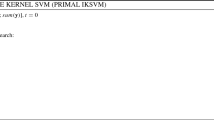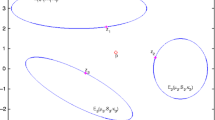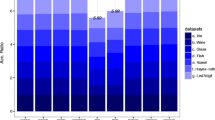Abstract
Indefinite kernel support vector machine (IKSVM) has recently attracted increasing attentions in machine learning. Since IKSVM essentially is a non-convex problem, existing algorithms either change the spectrum of indefinite kernel directly but risking losing some valuable information or solve the dual form of IKSVM whereas suffering from a dual gap problem. In this paper, we propose a primal perspective for solving the problem. That is, we directly focus on the primal form of IKSVM and present a novel algorithm termed as IKSVM-DC for binary and multi-class classification. Concretely, according to the characteristics of the spectrum for the indefinite kernel matrix, IKSVM-DC decomposes the primal function into the subtraction of two convex functions as a difference of convex functions (DC) programming. To accelerate convergence rate, IKSVM-DC combines the classical DC algorithm with a line search step along the descent direction at each iteration. Furthermore, we construct a multi-class IKSVM model which can classify multiple classes in a unified form. A theoretical analysis is then presented to validate that IKSVM-DC can converge to a local minimum. Finally, we conduct experiments on both binary and multi-class datasets and the experimental results show that IKSVM-DC is superior to other state-of-the-art IKSVM algorithms.
Similar content being viewed by others
References
Cortes C. Support-vector network. Machine Learning Journal, 1995, 20(3): 3–273
Cristianini N, Shawe-Taylor J. An Introduction to Support Vector Machines and Other Kernel-based Learning Methods. Cambridge: Cambridge University Press, 2000
Li Y Y, Lu R Q. Locality preserving projection on SPD matrix Lie group: algorithm and analysis. Science China Information Sciences, 2018, 61(9): 092104
Ma L R, Song D D, Liao L J, Wang J. PSVM: a preference-enhanced SVM model using preference data for classification. Science China Information Sciences, 2017, 60(12): 122103
Saigo H, Vert J-P, Ueda N, Akutsu T. Protein homology detection using string alignment kernels. Bioinformatics, 2004, 20(11): 11–1682
Wang C, Song Y, Li H, Zhang M, Han J. Text classification with heterogeneous information network kernels. In: Proceedings of the 30th AAAI Conference on Artificial Intelligence. 2016, 2130–2136
Vapnik V. The Nature of Statistical Learning Theory. Germany: Springer Science & Business Media, 2013
Suard F, Rakotomamonjy A, Bensrhair A. Kernel on bag of paths for measuring similarity of shapes. In: Proceedings of European Symposium on Artificial Neural Networks. 2007, 355–360
Chen Y, Garcia E, Gupta M, Rahimi A, Cazzanti L. Similarity-based classification: concepts and algorithms. Journal of Machine Learning Research, 2009, 10(3): 3–747
Chen Y, Gupta M. Fusing similarities and kernels for classification, In: Proceedings of the 12th International Conference on IEEE Information Fusion. 2009, 474–481
Pkalska E, Haasdonk B. Kernel discriminant analysis for positive definite and indefinite kernels. IEEE Transactions on Pattern Analysis and Machine Intelligence, 2009, 31(6): 6–1017
Sun H, Wu Q. Least square regression with indefinite kernels and coefficient regularization. Applied and Computational Harmonic Analysis, 2011, 30(1): 96–109
Ying Y, Campbell C, Girolami M. Analysis of svm with indefinite kernels. In: Proceedings of the 22nd International Conference on Neural Information Processing Systems. 2009, 2205–2213
Loosli G, Canu S. Non positive SVM. Technical Report, 2010
Haasdonk B. Feature space interpretation of SVMs with indefinite kernels. IEEE Transactions on Pattern Analysis and Machine Intelligence, 2005, 27(4): 4–482
Pekalska E, Paclik P, Duin R P. A generalized kernel approach to dissimilarity-based classification. Journal of Machine Learning Research, 2001, 2(12): 12–175
Graepel T, Herbrich R, Bollmann-Sdorra P, Obermayer K. Classification on pairwise proximity data. In: Proceedings of the 13th Conference on Neural Information Processing Systems. 1999, 438–444
Roth V, Laub J, Kawanabe M, Buhmann J M. Optimal cluster preserving embedding of nonmetric proximity data. IEEE Transactions on Pattern Analysis and Machine Intelligence, 2003, 25(12): 12–1540
Luss R, d'Aspremont A. Support vector machine classification with indefinite kernels. In: Proceedings of the 21st Conference on Neural Information Processing Systems. 2008, 953–960
Chen J, Ye J. Training SVM with indefinite kernels. In: Proceedings of the 25th International Conference on Machine Learning. 2008, 136–143
Chen Y, Gupta M R, Recht B. Learning kernels from indefinite similarities. In: Proceedings of the 26th International Conference on Machine Learning. 2009, 145–152
Gu S, Guo Y. Learning SVM classifiers with indefinite kernels. In: Proceedings of the 26th AAAI Conference on Artificial Intelligence. 2012, 942–948
Lin H T, Lin C J. A study on sigmoid kernels for SVM and the training of non-PSD kernels by SMO-type methods. Neural Computation, 2003, 3: 1–32
Akoa F B. Combining DC algorithms (DCAs) and decomposition techniques for the training of nonpositive-semidefinite kernels. IEEE Transactions on Neural Networks, 2008, 19(11): 11–1854
Ong C S, Mary X, Canu S, Smola A J. Learning with non-positive kernels. In: Proceedings of the 21st International Conference on Machine Learning. 2004, 81
Loosli G, Canu S, Ong C S. Learning SVM in Krein spaces. IEEE Transactions on Pattern Analysis and Machine Intelligence, 2016, 38(6): 6–1204
Alabdulmohsin I M, Gao X, Zhang X. Support vector machines with indefinite kernels. In: Proceedings of the 6th Asian Conference on Machine Learning. 2014, 32–47
Kotsiantis S B, Zaharakis I, Pintelas P. Supervised machine learning: a review of classification techniques. Emerging Artificial Intelligence Applications in Computer Engineering, 2007, 160: 3–24
Friedman J. Another approach to polychotomous classification. Technical Report, Department of Statistics, Stanford University, 1996
Krebel U. Pairwise classification and support vector machines. Advances in Kernel Methods: Support Vector Learning, 1999, 255–268
Bottou L, Cortes C, Denker J S, Drucker H, Guyon Z, Jackel L D, Le Cun Y, Muller U A, Sackinger E, Simard P, Vapnik U. Comparison of classifier methods: a case study in handwritten digit recognition. In: Proceedings of the 12th IAPR International Conference on Pattern Recognition. 1994, 77–82
Dietterich T G, Bakiri G. Solving multiclass learning problems via error-correcting output codes. Journal of Artificial Intelligence Research, 1995, 2: 263–286
Allwein E L, Schapire R E, Singer Y. Reducing multiclass to binary: a unifying approach for margin classifiers. Journal of Machine Learning Research, 2000, 1(12): 12–113
Piatt J C, Cristianini N, Shawe-Taylor J. Large margin dags for multi-class classification. In: Proceedings of the 12th International Conference on Neural Information Processing Systems. 1999, 547–553
Scholkopf B, Smola A J. Learning with Kernels: Support Vector Machines, Regularization, Optimization, and Beyond. Massackusetts: MIT Press, 2001
Tao P D, An L T H. Convex analysis approach to DC programming: theory, algorithms and applications. Acta Mathematica Vietnamica, 1997, 22(1): 1–289
Dinh T P, Le Thi H A. Recent advances in DC programming and DCA. In: Nguyen N T, Le-Thi H A, eds. Transactions on Computational Intelligence XIII. Springer, Berlin, Heidelbery, 2014, 1–37
Piot B, Geist M, Pietquin O. Difference of convex functions programming for reinforcement learning. In: Proceedings of the 27th Conference on Neural Information Processing Systems. 2014, 2519–2527
Xu H M, Xue H, Chen X H, Wang Y Y. Solving indefinite kernel support vector machine with difference of convex functions programming. In: Proceedings of the 31st AAAI Conference on Artificial Intelligence. 2017, 2782–2788
Artacho F J A, Fleming R M, Vuong P T. Accelerating the DC algo-rithmfor smooth functions. Mathematical Programming, 2018, 169(1): 1–95
Nesterov Y. Introductory Lectures on Convex Optimization: A Basic Course. Germany: Springer Science & Business Media, 2013
Wang Z, Xue X. Multi-class support vector machine. In: Ma Y, Guo G, eds. Support Vector Machines Applications. Springer, Cham, 2014, 23–48
Vapnik V N. Statistical Learning Theory. Wiley New York: John Wiley & Sons, Inc., 1998
Weston J, Watkins C. Multi-class support vector machines. Technical Report, Department of Computer Science, Royal Holloway, University of London, 1998
Crammer K, Singer Y. On the leamability and design of output codes for multi-class problems. Machine Learning, 2002, 47(2): 2–201
Blake C, Merz C J. UCI repository of machine learning databases, 1998
Ratsch G, Onoda T, Muller K R. Soft margins for AdaBoost. Machine Learning, 2001, 42(3): 3–287
Duin R P, Pekalska E. The dissimilarity representation for pattern recognition: a tutorial. Technical Report, 2009
Mosek A. The MOSEK optimization software. Google Website, 2010
Wu G, Chang E Y, Zhang Z. An analysis of transformation on non-positive semidefinite similarity matrix for kernel machines. In: Proceedings of the 22nd International Conference on Machine Learning. 2005, 1245–1256
Chang C C, Lin C J. LIBSVM: a library for support vector machines. ACM Transactions on Intelligent Systems and Technology, 2011, 2(3): 27
Zhang M L, Zhou Z H. Exploiting unlabeled data to enhance ensemble diversity. Data Mining and Knowledge Discovery, 2013, 26(1): 98–129
Acknowledgments
This work was supported by the National Key R&D Program of China (2017YFB1002801), the National Natural Science Foundations of China (Grant Nos. 61375057, 61876091 and 61403193). It was also supported by Collaborative Innovation Center of Wireless Communications Technology.
Author information
Authors and Affiliations
Corresponding author
Additional information
Hui Xue received the BSc degree in Mathematics from Nanjing Normal University, China in 2002. In 2005, she received the MSc degree in Mathematics from Nanjing University of Aeronautics & Astronautics (NUAA), China. And she also received the PhD degree in Computer Application Technology at NUAA, China in 2008. Since 2009, as an Associate Professor, she has been with the School of Computer Science and Engineering at Southeast University, China. Her research interests include pattern recognition and machine learning.
Harming Xu received the BS degree in School of Computer Science and Technology from China University of Mining and Techology, China in 2015. In 2018, he received the MSc degree in the School of Computer Science and Engineering at Southeast University, China. Now, he is a PhD candidate at the University of Adelaide, Australia. His research interests include pattern recognition, machine learning, and data mining.
Xiaohong Chen received the BSc degree in Mathematics from Qufu Normal University, China in 1998. In 2001, she received the MSc degree in Mathematics from Nanjing University of Aeronautics & Astronautics (NUAA), China. And she also received the PhD degree in Computer Application Technology at NUAA, China in 2011. She is an Associate Professor at the College of Science at NUAA, China. Her research interests include pattern recognition and machine learning.
Yunyun Wang received the BS degree in computer science and technology from An-hui Normal University, China in 2006, and the PhD degree in computer science and engineering from the Nanjing University of Aeronautics and Astronautics, China in 2012. She is currently an associate professor with the Department of Computer Science and Engineering, Nanjing University of Posts & Telecommunications, China. Her current research interests include pattern recognition and machine learning.
Electronic supplementary material
Rights and permissions
About this article
Cite this article
Xue, H., Xu, H., Chen, X. et al. A primal perspective for indefinite kernel SVM problem. Front. Comput. Sci. 14, 349–363 (2020). https://doi.org/10.1007/s11704-018-8148-z
Received:
Accepted:
Published:
Issue Date:
DOI: https://doi.org/10.1007/s11704-018-8148-z




